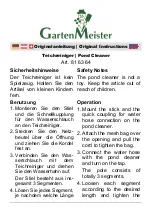
4 — English
SPECIFIC SAFETY RULES
Know the contents of the chemical being sprayed.
Read all Safety Data Sheets (SDS) and container
labels provided with the chemical.
Follow the chemi-
cal manufacturer’s safety instructions. It is a violation
of federal law to use an EPA-approved disinfectant in a
manner inconsistent with its labeling.
Do not leave residue or spray material in the tool, its
accessories, or containers after using the sprayer.
Clean after each use.
Maintain this product. Thoroughly inspect both the
inside and outside of the sprayer and examine the
components before each use. Check for cracked and
deteriorated tanks, leaks, clogged nozzles, and miss
-
ing or damaged parts. If damaged, have the product
repaired before use.
Many accidents are caused by
poorly maintained products.
Disconnect the battery from the unit before draining,
cleaning, or storing the sprayer.
Such preventive safety
measures reduce the risk of accidental starting.
SAVE THESE INSTRUCTIONS
Always wear eye protection with side shields or
goggles marked to comply with ANSI Z87.1.
Failure to
do so could result in fluids entering your eyes resulting in
possible serious injury.
Protect your lungs. Wear a face or dust mask when
using the sprayer.
Following this rule will reduce the risk
of serious personal injury.
Keep handles and grasping surfaces dry, clean and
free from oil and grease.
Slippery handles and grasping
surfaces do not allow for safe handling and control of the
tool in unexpected situations.
Battery tools do not have to be plugged into an elec
-
trical outlet; therefore, they are always in operating
condition. Be aware of possible hazards when not
using your battery tool or when changing accessories.
Remove battery pack when tool is not in use.
Follow-
ing this rule will reduce the risk of electric shock, fire, or
serious personal injury.
For outdoor use only.


























